| So many people have made these shoes that we’ve had to open a second gallery! The shoes on these pages were made with Tacky Living’s baby shoe pattern. For more information and tips, please also see the baby shoe FAQs.
Have you used our pattern? We’d love to see what you did, and other readers would too! Send photos via contact us. |

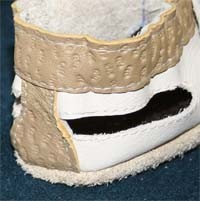
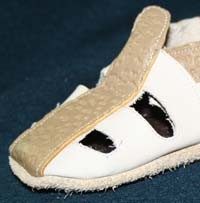
|
|
Lynn Sickinger
This is creative! Look what Lynn has done – she’s carefully added some openings, which convert the basic shoe pattern to a sandal:
“I love your shoe pattern. The shoes look so adorable on my grandson. I made a pair of shoes a few months ago, but now since the warm weather is here I thought I would adapt the pattern to make a pair of sandals. Here are the results. Thank you so much for sharing this wonderful pattern with us!”
Leather and other non-fraying materials are probably best for this adaptation. Otherwise, one would have to fiddle around with finishing the edges of the ventilation openings. However, it never hurts to experiment – the materials are fairly inexpensive, and that’s how new and clever developments are made.
Lynn appears to be something of an expert of sewing with leather. A photo of another pair of equally crisp and professional-looking shoes she made is below. |
|
|
|
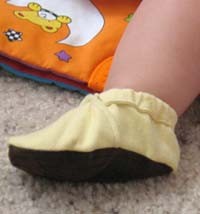
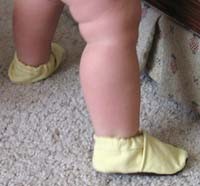
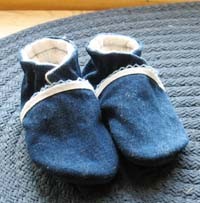
|
|
Marcy Prochaska
Before we discuss and admire the shoes … just look at those little legs! Is there a more wonderful, perfect substance on this planet than baby skin? Those legs surely must get kissed a lot.
Onward to the shoes – Marcy has several helpful tips to share:
“Like several others, on the first pair* I made the casing by extending
and folding the back. The soles are nubuck, stitched in a spiral to the
linings since I had no wonder-under on hand. They’re self-lined in a
yellow linen-blend leftover from making a sling and a baby dress.
For my second pair, I experimented with paper to adjust the pattern for
a more asymmetrical shape, and I also made the back high-topped — I
stitched two guidelines for the elastic between the back and the
lining. These are denim with a blue-scalloped binding on the vamps, white
flannel linings, and blue leather scraps, soft side out, from the shoe
repair shop.
*First successful pair, that is. My first attempt, in denim with
flannel linings, didn’t work so well as I had trouble catching all the layers
in the seam. I have found that with slippery or stiff or otherwise
difficult fabrics, stitching all around the vamp before sewing it to
the sole keeps the layers together nicely.”
Marcy’s point about stitching around the vamp before sewing it to the sole is well-taken, and hopefully will save others some frustration.
|
|
|
|
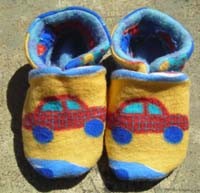 |
|
Anita Morgan
You’d never know it to look at this pair of shoes, but Anita is a beginning sewer. Didn’t she do a great job?
“Thanks very much for making your pattern available free of charge 🙂 I was thrilled with how this pair turned out, considering I really am a beginner at sewing. I made the outside from flanelette I got from a second-hand store for $1.50 for a roll of 2 metres, the inside from polar fleece I had lying around and the soles are made of denim for indoor walking. I’m going to attempt some more very soon and can’t wait! I positioned the cars right on the front as my husband is a real car fanatic and my little boy is growing into it already- he’s only 1!”
|
|
|
|
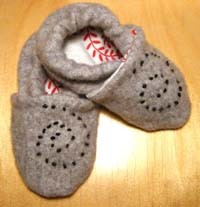
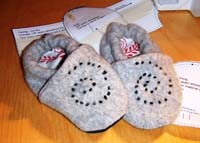
|
|
Leslie Bocanegra
We’d previously heard from Leslie when she made some black leather shoes from recycled leather. This time, she very cleverly gave another type of material a new chance at life.
“We have a spot of cold weather here in Switzerland, so I made another
rather cozy pair, this time using the sleeves of an old felted
sweater. The “embellishment'”are simple french knots, the lining an
old pillowcase and the leather sole came from a leather vest I bought
at our local thrift store – same leather I used for the first pair,
which my husband now calls the “biker booties”.”
It’s interesting to see that such a strong design element can be made with french knots. Leslie’s ingenious use of recycled materials is also a pleasure to behold.
|
|
|
|
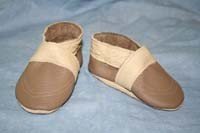 |
|
Lynn S.
“I loved making shoes for my grandson from your pattern. So cute, such fun!”
Lynn created the crisp, clean, beautifully professional-looking shoes at left. Notice the contrasting strip she added to the top of the vamp, which adds an interesting design flourish. Thanks to her, her grandson will surely have no lack of elegant footwear. |
|
|
|
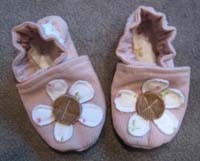
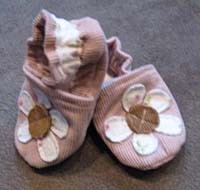
|
|
Lyndsy Davis
We were tickled to hear the following from Lyndsy:
“I just wanted to say thank you for allowing me to download the shoe pattern online. I made my own pattern that was similar but just wasn’t working right, and so I investigated online and found your website. I have since made these adorable little shoes, and will probably make one hundred more.”
Judging by the beautiful shoes she made, if she makes a hundred pairs, there will be a hundred or so very lucky little feet.
|
|
|
|
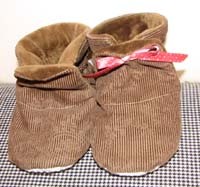
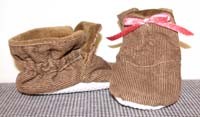
|
|
Jaime Jolley
Jaime’s shoes are very tasteful pairing of velour and corduroy:
“I had some really cute high top version of the same type of shoe from Old Navy, that I love but my daughter is growing out of them, so a friend gave me this site and I adapted the pattern to make a high top version. I reinforced along where your original seam would go for stability for the elastic and stitched down the top of the tongue part just for looks. I didn’t dress them up very much cause I wasn’t sure they would even work. Maybe I can still stitch something pink on. I used corduroy outside, grippy dotty bottoms, and some type of soft velour or something for the inside, which was hard to work with but really cozy. My other bow wasn’t stitched on very well and already fell off.”
Actually, the bow coming off one shoe is serendipitous for us, since it lets us compare what the shoe looks like with it versus without. When it’s on, it gives the shoes a bootie-like feeling that is just right. When it’s off, we can see that these shoes would work well for either a little boy or a girl. Good work, Jaime!
|
|
|
|
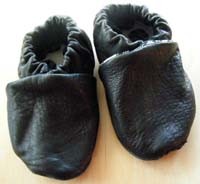
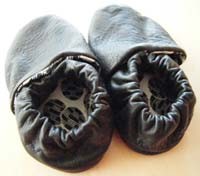
|
|
Leslie Bocanegra
Leslie’s contribution to the gallery are some crisp, professional-looking shoes that would look nice with both casual outfits and when dressing one’s child up a bit.
“I recently used your pattern to make my son some soft leather shoes.
The turned out pretty well, if I say so myself – he prefers them over
the Robeez ones.
Your instructions are excellent. My only modification was to make the
back in one piece by cutting back and casing as one. The are made from
soft goat leather scraps and lined with quilting fabric.”
|
|
|
|
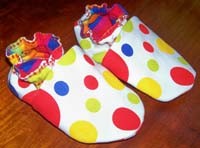
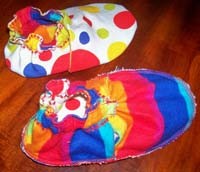
|
|
Fiona Darby
A frequent creator of baby shoes for her own child, Fiona has now began making them for others:
“They are actually slippers for a friend’s two-year-old son. The two photos I have sent show you the finished pair and also a photo of the spotty outer fabric and the rainbow coloured lining.”
With this bright, playful fabric, the slippers are sure to be a hit with almost any two-year-old!
“They are 100 % cotton, which I have found hard to find in store-bought slippers these days! The spotty outer fabric is thicker than the rainbow-coloured lining which can be seen in the second photo where I have turned one slipper out to show you.
I love these fabrics because they are bright and fun. This time I did not use the rubber-type non-slip fabric for the sole as I have previously (the reason being that this pair are slippers and will only be worn inside, mostly on carpeted floor.) The sole is simply the same as the spotted outer fabric.
On the back of the slipper at the top I used some decoration of some star stitching in red cotton as I felt any more than this would have just been too ‘busy’.
To make these, the total fabric cost was only AUS$2.20 and I still have some of it left (will use this for a patchwork project I am planning.)” |
|
|
|
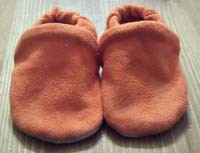 |
|
Barbara Liguori
Barbara made these cuddly soft slipper-like shoes from a piece of stretch suede. We anticipate that her child is going to have very happy toes!
“My 3yo has a collection of Moss Feet shoes (love them but I don’t think she’s in business anymore). Since my 1yo is baby #4 I didn’t think I would be able to swing a different pair of shoes for every day of the week, until now – hooray!
I did change the back. Instead of doing the casing separate I just cut the piece on a fold and stitched a bit from the edge to make a casing.”
|
|
|
|
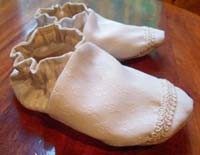 |
|
Fiona Darby
We’re always glad to hear from Fiona, who has shown great creativity in using this pattern on numerous occasions. (More of her work can be seen by scrolling down through the page.)
“I sewed these shoes for Roy’s baptism outfit. The back of them is the same pinstripe that I used to sew his pants. and the toe is a satin jacquard patterned fabric that I used to sew his vest. I trimmed the vest I made him with the little trimming on the toe so that matches well too. I lined them with a plain cream cotton fabric. He is now two-and-a-half years old and trying to hold him and encourage him to stay relatively still during the ceremony made me think that some soft shoes would be useful for him to wear. It will make his wriggling around less painful for us than if he were to wear hard-soled shoes! I also couldn’t think of a better matching pair of shoes for his outfit. These will definitely be a keepsake.”
A keepsake indeed, and probably one of the nicest ones a person could be kicked with!
|
|
|
|
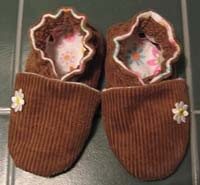 |
|
Kara S.
“Thank you so much for this pattern! I’m new to sewing & even I could do it 🙂 I followed some of the suggestions & used corduroy for the soles (& the whole shoe for that matter) & put the casing inside the shoe. These are sooo cute! I made mine out of brown corduroy with little daisies on the front, & the lining is a light patterned fleece material… actual cost to make these, probably only about $5! So much better than the $30 or $40 you find at the store, and my daughter can wear these with just about any of her outfits! “
We admire the way Kara used a color which isn’t traditionally associated with little girls, brown, yet created a feminine-looking shoe. No one would guess that she’s new to sewing.
|
|
|
|
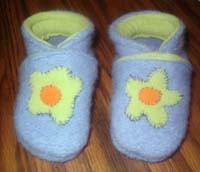 |
|
Amanda Mitchell
“Here are my first pair! I followed your pattern somewhat and added my own things in as well. I used some leftover felted/boiled wool from a sweater that I had used to make a pair of Longies (Cloth Diaper cover/pants in one). I lined most of the inside with micro-fleece. These shoes are super soft and warm- just in time for fall/winter! I added on the flower decal with the same green micro-fleece and round orange micro-fleece pieces. I really like the way they came out. I can’t wait to make a bunch more with different fabrics. They were soooo easy to make, not anywhere as complicated as I thought they would be. Thanks so much for posting this pattern and directions.”
The soft texture and colors of these shoes say “baby”! Didn’t she do a great job?
|
|
|
|
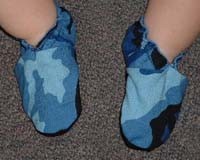 |
|
Julie in Ontario, Canada
“I just wanted to share a photo of the first pair I have made.
I made them with left over material from making Mei Tais, they are lined with flannel and the bottoms are corduroy. I will be making many more!”
These look soft and comfortable, and we highly approve of the use of materials that might otherwise go to waste.
|
|
|
|
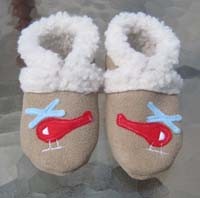 |
|
Erica Penner
“I made these for a friend who is a Naval helicopter pilot. They were really easy to make using bonded suede/polar fleece, so you do not need to line them.”
They look wonderful, warm and cozy. Great job, Erica!
|
|
|
|
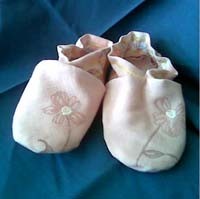
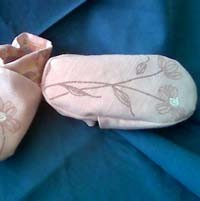
|
|
Scout Granier
Scout has been busy making shoes for friends and family alike:
“I made up a pair of baby shoes from your pattern for a little friend’s first birthday, and can’t wait to make some more for my little guy. The pattern was so easy, and so quick, and turned out so fabulous, I was shocked at myself!”
For the friend, a little girl, she raided her stash and added a dose of ingenuity:
“The fabrics I used were just what I could dig out of my stash that were soft and girly. … I did put a couple of decorative lines of satin stitch around where I sewed in the casing – I didn’t have any matching pink thread, so I had to go with yellow, and the satin stitch was to make it look like I had planned it that way!”
We like Scout’s shoes, and evidently the recipient did too:
“(she) was enamored enough by her new shoes that they drew her attention away from the loud noisemaking piano for a few seconds at the birthday party.”
|
|
|
|
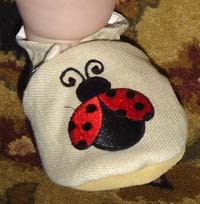
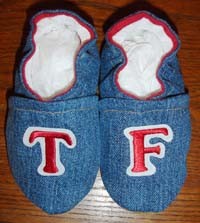
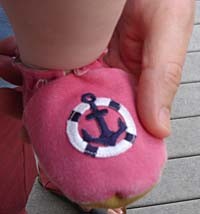
|
|
Annie Rota
“I’ve bought exactly zero pairs of those other shoes (or even the Target knock-offs!) since finding your pattern. For the small investment in some pieces of suede and cute appliqués at the craft store, I’ve made several more pairs! … our day care teachers are endlessly amused by all the silly shoes.”
At left, from top to bottom, we have custom made slippers featuring ladybug appliques, shoes custom made for a friend’s birthday, and a very special pair of shoes celebrating Father’s Day at the yacht club. The ladybug and nautical shoes include a glimpse of the most perfect substance on earth, baby skin.
|
|
|
|
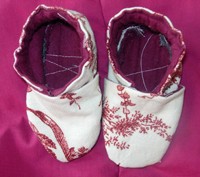 |
|
Daniella Alejandro
Daniella’s shoes feature corduroy soles, which may be a nice alternative to leather for non-walking children of vegetarians.
“I found a scrap of toile standing in line at the fabric store in the discount bin. I lined the shoes with cotton flannel and used corduroy for the soles.”
While standing in line can be tedious, it sounds as though Daniella made good use of her time!
|
|
|
|
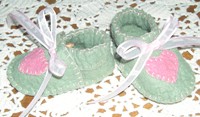
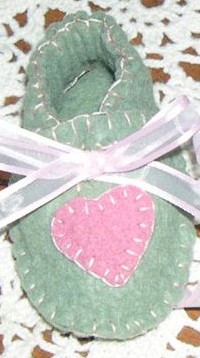
|
|
Paula Parker
These darling pink and green crib shoes were quite economically, using leftovers from Paula’s rug-making endeavors:
“Here are a pair of crib shoes that I made from your pattern.. they are darling! I used felted wool felt ..single layer..all hand sewn with the blanket stitch. I love making the penny rugs and adapted these using scraps…Thanks for the wonderful pattern..I’m sure there will be plenty more coming!”
Cute and cheap – we like that!
|
|
|
|
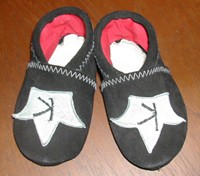 |
|
Sirorat Heyden
The appliqued crowns on the little shoes at left would make any child feel like a little prince or princess! They’re the work of Sirorat Heyden, from Germany, who was kind enough to let us know that she’d tried the shoe pattern:
“Your baby Shoe pattern was very easy to follow. I have made 5 shoes already! It was extremely easy and Fun!!”
We’re very glad that you enjoyed it, Sirorat!
|
|
|
|
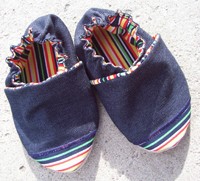
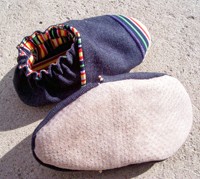
|
|
Fiona Darby
The crisp, cheerful shoes at left were made from navy blue denim and lined with a bright striped cotton. Additional striped fabric was used in the toe area as a design accent. Fiona tells us:
“I got the stripey fabric very cheaply (only AUS$1 per metre!). I have again used the non-slip rubber, dotted soles.
Roy is now almost 22 months old and this is the third pair of your shoes I have made for him. I get lots of comments about them whenever he wears them. I like him to wear soft shoes when he’s inside at his music group for instance and he has to sit on my lap during it (as when he wears heavy shoes, they can really pack a punch when he kicks me!). The soft shoes are much better for occasions like this!”
These look perfect for a summer’s day or a good run along the beach; we can understand why Roy is kicking his heels up in joy!
|
|
|
|
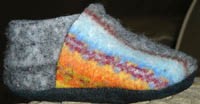
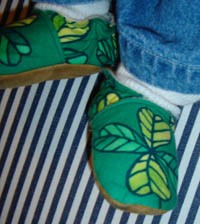
|
|
Annie Rota
The shoes at left are a great example of how one can create footwear that is clever, original and inexpensive:
“I’ve finished 2 pairs and a third is just waiting for some elastic, and the only thing I’ve had to go buy was leather for the soles. And they’re a perfect bite-sized project for a working mom who wishes she had more hours in her days and longer weekends.”
A savvy use of available materials, the wool shoes were made from an old wool sweater that Annie felted:
“The wool pair is unlined (would’ve been too thick), so I just made a little loop of bias tape to hold the elastic in place on the inside of the vamp.”
After looking at the pattern and reading others’ experiences, Annie could see that making the casings and feeding elastic through them would be the most time-consuming steps. To simplify matters, she decided to make her casings from packaged double-fold bias tape and place them on the insides of the shoes. She then streamlined the process of inserting the elastic:
“Instead of threading the elastic through the casing, I started with a piece of elastic about 2 inches longer than the casing. I stitched down one side of the casing, pinned the elastic in place, and stitched down the other side, being careful not to hit the elastic. Once construction was complete, I trimmed off the extra elastic. I think the time and aggravation I avoided were worth the wasted few inches of elastic! :-)”
|
|
|
|
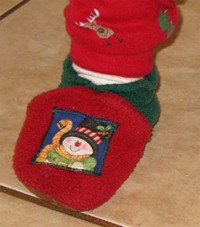

|
|
Jordan Domanski
When winter rolled around and her tile floors grew cold, Jordan Domanski sewed up a fleecy solution:
“My toddler has very long, very skinny feet and finding houseshoes for him has been a challenge. Most of the department store houseshoes are too bulky and have character heads sticking off them – a recipe for tripping disaster if ever I saw one. The floors in our home get so cold that I wanted him to have something besides just socks, so using your pattern I whipped up a pair of slippers for him right after Thanksgiving. He has loved these through the holiday season and beyond.”
It’s no wonder; what toddler wouldn’t like these colorful, warm fleece slippers made with appliques and a dose of mommy love? Jordan says she isn’t done, though:
“I’m planning an Elvis pair for him next – bwah ha ha!” |
|
|
|
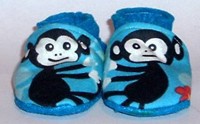

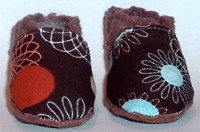
|
|
Sandy Hogue
With baby number four soon on the way, Sandy Hogue’s thoughts turned to baby shoes:
“I used this pattern for my soon to be born baby boy(baby#4). We have many pairs of the “other shoes.” But at $20+ a pair I wasn’t going to buy many, that’s for sure! Plus I am a designer/sewer/owner of an online baby boutique and I am way too spoiled to be limited to the small selections I find online. This way he can have a pair to match every outfit! I used scraps from my other projects..scraps that I’m surprised had not been thrown away and craft felt (.20 cent a sheet can make a pair of newborn sized ones). Total cost of each pair..about .30 and that’s a high estimate.”
This is one newborn who’s going to be attired stylishly! One might even say that he’ll be wearing “Hogue Couture” |
|
|
|
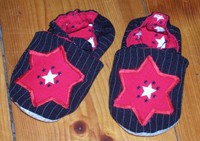
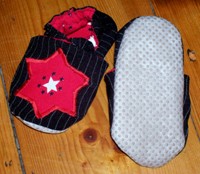
|
|
Fiona Darby
Fiona Darby, more of whose work can be seen below, sent us photos of a very special pair of shoes she made for her toddler:
“… they match some black pin-stripe pants I’ve made him as part of his magician’s outfit for going to a circus theme birthday party … I made him a vest out of the red fabric with the stars on it, so I used a cookie-cutter to trace a shape onto the red fabric and appliqued a star onto the front of the shoe and used this fabric as lining material too!”
Fiona’s use of a cookie cutter to design an applique is very clever. Her shoes also include another special touch, the use of non-slip fabric on the soles. This is a nice alternative for shoes that aren’t going to get heavy wear, or for those who would simply prefer to not to use leather. |
|
|
|
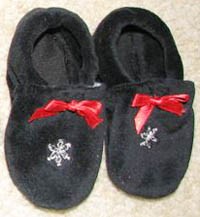
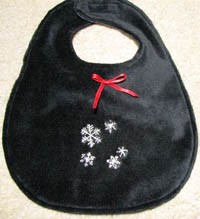
|
|
Marna Balazer
This lovingly embroidered matching shoe and bib set was made by Marna Balazer to coordinate with her granddaughter’s red and black velvet Christmas outfit.
The combination of bows, embroidery and velvet gives these shoes a classic, somewhat formal look. This is a good example of how materials and embellishments can be used to achieve different effects. |
|
|
|
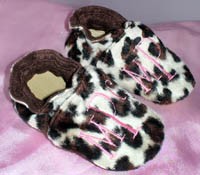 |
|
Carolyn Pruitt
When Carolyn Pruitt’s daughter needed shoes, Carolyn fired up the sewing machine and reached for the faux fur, creating the warm and whimsical slippers pictured at left. In addition to a faux fur exterior, they feature faux suede lining and a lovingly monogrammed vamp. A sheet of suede was used for the soles, which were left unlined:
“The pattern was very easy to follow. The only thing I didn’t follow was lining the leather sole. My name brand pair aren’t lined and the suede is very soft. My daughter usually wears hers with socks anyway. … I can see that many more will be on the way!!! A girl has gotta have shoes!” |
|
|
|
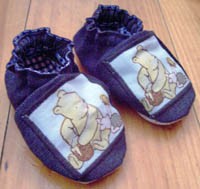 |
|
Fiona Darby, in Australia
The adorable shoes at left were lovingly crafted by Fiona Darby for her young son Roy:
“He is 16 and a half months old and these are the first shoes he used to walk outside. As he is not walking completely steadily on his own yet, the shoe shop here didn’t want to fit him with any other shoes at the moment because he would just end up scuffing the toe area when he went down to crawl at times between walking.”
Fiona chose dark stretch denim for the outside and blue cotton gingham fabric for the inside, and embellished the vamp with a Winnie-the-Pooh motif. She also came up with an innovation that vegetarians and others who don’t care to use leather may prefer, using a non-slip fabric for the sole:
“The shoe sole is a type of rubber which they call grip-fabric. It has little dots all over it. It is not leather. I am unsure of its exact name… I followed your other reader’s suggestion and put the casing on the inside of the shoe. It was such fun making them!”
Fiona’s son was appreciative, which made her efforts doubly worthwhile:
“We ‘roadtested’ them on our son the other day and he loved wearing them and walking down the street outside for the first time. It was so cute to see. I got some great comments from a waitress at a restaurant we were at who said how cute the shoes were and when I said I had made them she was amazed. I am keen to make more of them, also slipper ones too in a softer material.”
The shoes will also become a family heirloom, all the more special because they were hand made: “I will also keep them in his keepsake box when he has finished with them.”
|
|
|
|
 |
|
Tacky Living
Uppers were made from an old apron salvaged from the garage, decorated with colorful flannel appliques. Leather for the soles was bought on sale at a local crafts store. |
|
|
|
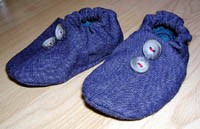 |
|
Solveig Petch
Like many other Tacky Living readers, Solveig Petch had trouble finding affordable shoes that would fit her baby
“My 6 1/2 month old son is a big baby, and I find that ‘normal’ baby shoes in size 6-12 months are long enough, but not wide enough, and I struggle to put them on him. The only shoes that fit without making him look like a clown are the soft ones like the ones your pattern make, but they are so expensive to buy!”
Solveig’s first pair of shoes, shown at left, were made from old clothing. This is a clever way to recycle materials and test the pattern before investing money.
“I had a go today and made a pair for no money at all, using scrap bits of denim from an old pair of jeans, and lined them with material from an old T-shirt! Now I know the sizing is right and the pattern is great I will go out and buy a piece of nice soft leather to make him a sturdier pair for autumn and winter!”
Solveig also came up with her own clever customization to the pattern, which others may prefer as well:
“The only modification I have made to your pattern is I have eliminated the need for the casing for the elastic by making the backs longer and hemming them down. This seemed to work too, and meant less work!” |
|
|
|
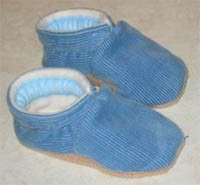 |
|
Michelle Guilmet
These cheerful, cozy-looking shoes were created by reader Michelle Guilmet for her baby boy.
‘”I bought a pair of the overpriced shoes you allude to on your web page and they were too tight for my ’97th percentile’ baby boy. Do you know how hard it is to find baby shoes for a baby with feet the size of a toddler’s?!”
Michelle’s use of fabric is clever, providing a good example of how the same basic pattern can yield radically different looks. Any child would feel cherished wearing the snuggly corduroy and microfleece shoes at left, while the contrasting vamps and backs of the pair below give them an especially playful look.
She made many improvements to our construction methods, including using packaged fleece bias tape for the casing. This simplifies the tedious step of creating the casing. She also placed her casing on the insides of the shoes, which gives them a more polished appearance than when they’re on the outside.
Her shoes are lined with microfleece, which is soft and comfortable when her son goes without socks. Finally, since her son is not walking yet, it wasn’t necessary to sole the shoes with leather; scraps of corduroy were used instead.
|
|
|
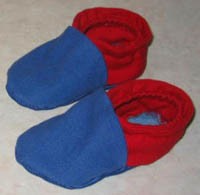 |
|
|
|
|
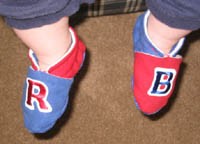 |
|
Yet another example of Michelle’s clever use of fabric, modeled by her young son.
|
|
|
|
|